<< Previous | Displaying results 6501-6550 of 6707 for "" | Next >>
-
Execution of Polish civilians in the forest near Tuchola
PhotoThe execution of Polish civilians by the Selbstschutz (ethnic German self-defense organization) and SS in the forest near Tuchola. Bydgoszcz, October 27, 1939.
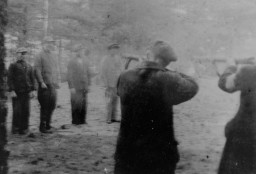
-
Group of Polish civilians before execution
PhotoAn SD officer reads a list of charges against a group of Polish civilians just before their execution in the forest near Szubin. A German soldier can be seen in the left background and a woman is included in the number of those to be shot. According to the Main Crimes Commission, one of the officers involved is SS Major Ernst Tiedemann. Szubin (Bydgoszcz), Poland, October 21, 1939.
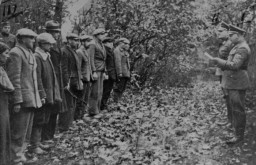
-
Polish civilians are forced to dig a mass grave
PhotoPolish civilians under SS and Selbstschutz (ethnic German self-defense organization) guard are forced to dig a mass grave prior to their execution in the forest near Tuchola. Tuchola Forest, Bydgoszcz, Poland, October 27, 1939.

-
Execution of Polish teachers
PhotoTeachers from Bydgoszcz and the surrounding area a few moments before their execution by firing squad in the "Valley of Death" near Fordon. The first in line is Wladyslaw Bielinski, a primary school teacher from Wiag. The Nazis sought to destroy Polish culture and the Polish nation, and eliminate any resistance, by arresting and murdering Poles. German police, SS, and army units and ethnic German “self-defense” forces shot thousands of Polish civilians. Among those shot were wealthy landowners, some…
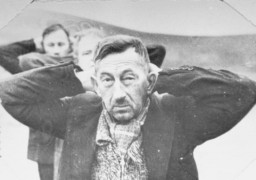
-
SS personnel lead Polish women into a forest for execution
PhotoPolish women from the Pawiak and Mokotow prisons in nearby Warsaw are led into the Palmiry forest for execution by SS personnel.The original caption reads: "Their Nazi executioners leading a group of Polish women, according to the information attached to this picture which was just received through Polish sources. Hundreds of cvilians, men, women and even young children are said to be systematically 'eliminated' under the Nazi scheme of things in war-torn Poland". Palmiry Forest, Poland,…
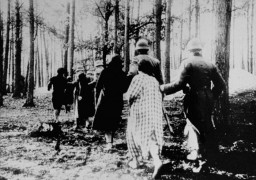
-
The Armia Krajowa during the Warsaw uprising
PhotoMembers of the Zoska battalion of the Armia Krajowa stand atop a German tank captured during the 1944 Warsaw uprising. The tank was used by the battalion during its capture of the Gesiowka concentration camp. Warsaw, August 2, 1944.
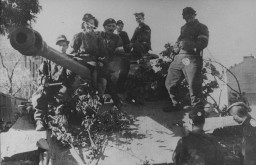
-
Jews liberated from the Gęsiówka camp during the Warsaw uprising
PhotoA member of the Zoska battalion of the Armia Krajowa escorts two of 348 Jews liberated from the Gęsiówka concentration camp during the Warsaw Polish uprising. August 5, 1944.

-
Soldiers of the Armia Krajowa
PhotoSoldiers of the Polish Home Army (Armia Krajowa) take cover behind a barricade during the Warsaw Polish uprising. During the uprising, the Home Army was supported by 2,500 soldiers from other resistance movements, such as the National Armed Forces (Narodowe Siły Zbrojne, NSZ) and the communist People's Army (Armia Ludowa, AL). Only a quarter of the partisans had access to weapons, fighting against 25,000 German soldiers equipped with artillery, tanks, and air forces. Two of the three soldiers shown here…

-
Female Soldiers of the Polish Home Army
PhotoSoldiers of the Polish Home Army Women's Auxiliary Services, taken captive by the Germans in October 1944 as a result of the Warsaw Polish uprising. After the uprising ended on October 2, the Germans took as prisoners of war more than 11,000 soldiers of the Polish Home Army.

-
Buildings destroyed during the Warsaw Polish uprising
PhotoPlanned as a short military revolt, the Warsaw Polish uprising lasted 63 days, from August to October 1944. In the end, German troops destroyed the majority of Warsaw during and immediately after the uprising. Photo dated January 17, 1945.
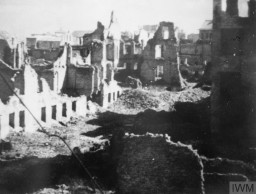
-
Warsaw Polish uprising
PhotoSoldiers from the Kiliński Battalion of the Polish Home Army take a German prisoner during the Warsaw Polish uprising. August 20, 1944.
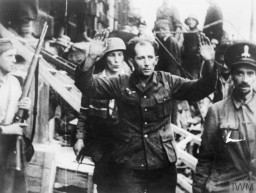
-
Destruction in Warsaw
PhotoFollowing the German invasion of Poland on September 1, 1939, Warsaw suffered heavy air attacks and artillery bombardment. German troops entered the city on September 29, shortly after its surrender. This photograph was taken by Julien Bryan, an American documentary filmmaker who captured the German bombardment and its impact on the Polish citizenry. Warsaw, Poland, ca. 1939.
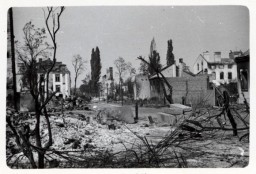
-
Home destroyed during Warsaw bombing
PhotoMembers of a Polish family perform daily chores amidst the amidst the charred ruins of their home, destroyed during the German bombing of Warsaw. They have reassembled the remnants of their household furnishings outside. Photographed by Julien Bryan, circa 1939.

-
Polish children wander through the ruins of Warsaw
PhotoPolish children wander through the ruins of Warsaw after a German bombing. Photographed by Julien Bryan in Warsaw, Poland, ca. 1939.
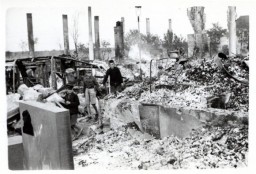
-
Victim of a German air raid
PhotoA ten-year-old Polish girl, Kazimiera Mika, mourns the death of her older sister, who was killed in a field in Warsaw, Poland, during a German air raid. Photographed by US documentary filmmaker, Julien Bryan, on September 13, 1939.
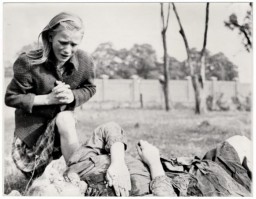
-
Father Wlodarczyk tries to clean a bombed-out church
PhotoFather Wlodarczyk attempts to clean and repair a bombed-out church in the besieged city of Warsaw. Photographed by Julien Bryan, Warsaw, Poland, ca. 1939.
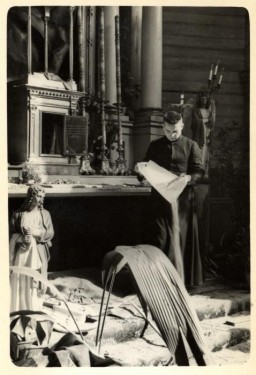
-
Judge Benjamin Barr Lindsey
PhotoAmerican judge Benjamin Barr Lindsey and his wife on a ship. Judge Lindsey's writings were among the texts the Nazis singled out during the 1933 public burnings of books. Photo dated December 4, 1915.

-
John Reed
PhotoPortrait of American journalist John Reed, circa 1914. Reed's book Ten Days that Shook the World was among the texts Nazi students burned in 1933.
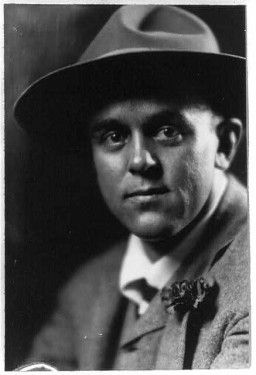
-
Morris Hillquit
PhotoBorn in Riga, Morris Hillquit became a prominent theoretician of the socialist movement after immigrating to the United States. The German translation of his work Socialism in Theory and Practice was burned in Nazi Germany in 1933. Photo taken circa 1910–1915.
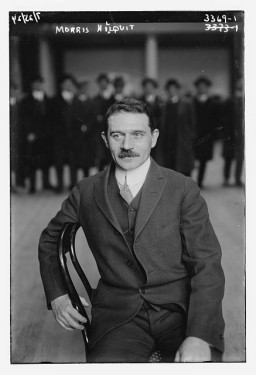
-
Nazi propaganda depicting prominent Jewish figures
PhotoNazi-produced propaganda slide entitled "Leading Figures of the System." The image was presented during a lecture called "Jewry, Its Blood-based Essence in Past and Future," Part I in a series on Jewry, Freemasonry, and Bolshevism. Germany, circa 1936. The slide features the portraits of six prominent Jewish political and cultural figures in Weimar Germany. Georg Bernhard, Rudolf Hilferding, and Walther Rathenau were among the authors whose works were targeted during the 1933 Nazi book burnings.
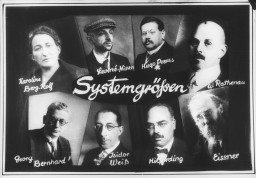
-
Portrait of writer Sigrid Undset
PhotoPortrait of writer Sigrid Undset, who won the Nobel Prize for Literature in 1928. Often with feminist themes, her novels were banned and burned in part because of her public criticism of the Nazi regime. Photo taken by Anders Beer Wilse on July 1, 1923.
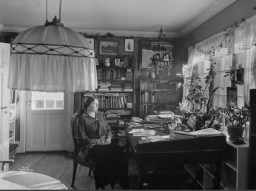
-
Sigrid Undset
PhotoSigrid Undset's novels were among the texts the Nazis banned and burned. Undset had previously won the Nobel Prize for Literature in 1928.
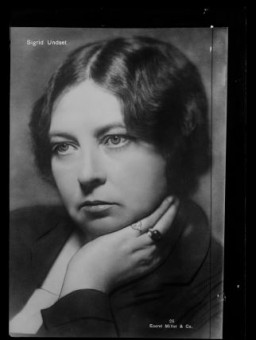
-
Vladimir Lenin
PhotoVladimir Lenin was the leader of a faction of Russian communists known as the Bolsheviks. After the Russian Revolution broke out in 1917, Lenin seized control and established the Soviet Union. Photographed circa 1920. The Nazis had declared themselves the sworn enemies of Bolshevik Russia, its architect and dictator Vladimir Lenin, and his successor Josef Stalin.
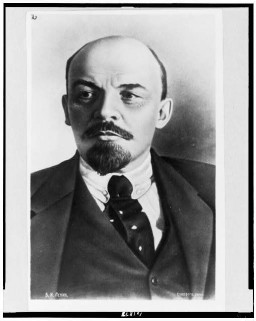
-
Joachim von Ribbentrop
PhotoForeign Minister of Germany from 1938 to 1945, Joachim von Ribbentrop sits in his cell during the Nuremberg trials. Photographed circa November 20, 1945 – October 01, 1946.

-
Propaganda slide for Hitler Youth
PhotoPropaganda slide for a Hitler Youth educational presentation entitled "German Achievements in the East." Circa 1934–1937.
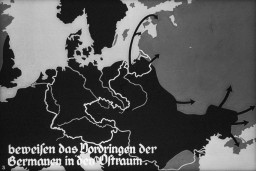
-
Prisoners in the roll call area at Melk
PhotoNewly arrived prisoners are assembled in the Appellplatz (roll call area) at the Melk camp, a subcamp of Mauthausen in Austria. 1944–45.

-

-
Nazi "Euthanasia" Program
PhotoPsychiatric patients are evacuated to clinics where they will be murdered as part of the Nazi Euthanasia Program. Photo taken in Germany and dated circa 1942–1944. The term "euthanasia" usually refers to causing a painless death for a chronically or terminally ill individual who would otherwise suffer. In the Nazi context, however, "euthanasia" was a euphemistic or indirect term for a clandestine murder program that targeted individuals with physical and mental disabilities.

-
Nazi Racial Propaganda
PhotoNazi propaganda depicting two racial portraits of individuals considered non-Aryan. The original caption reads: "Then these are barely recognizable as human beings." Circa 1933–1943.

-
Segregation in the United States
PhotoA segregated drinking fountain on the county courthouse lawn in Halifax, North Carolina. Photographed by John Vachon in April 1938.
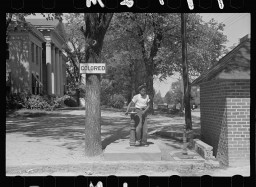
-
The Ku Klux Klan
PhotoThe Ku Klux Klan marches down Pennsylvania Ave in Washington, DC. Photograph by Harris & Ewing, 1926.
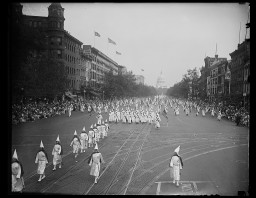
-
American cartoon responding to racism and the refugee crisis
PhotoCartoon depicting the United States' response to the refugee crisis in Europe, as well as the racism and discrimination African Americans faced at home. The Pittsburgh Courier, April 16, 1938. Page 10. Domestic concerns in the United States, including unemployment and national security, combined with prevalent antisemitism and racism, shaped America's immigration policies, responses to Nazism, and willingness to aid European Jews.
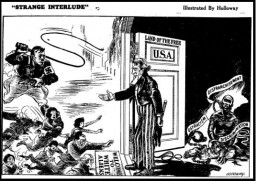
-
German occupation of Poland
PhotoA German soldier guards a group of Poles and Jews who have been rounded-up and forced to stand in a line with their arms raised, Poland, September 1939.

-
Destruction in Belarus
PhotoGerman troops view the burning of a village in the Rogachyevo district of Gomel, Belarus, 1941.
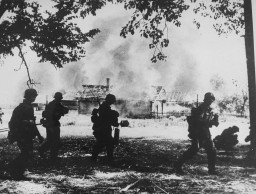
-
German treatment of Soviet POWs
PhotoA German guard sitting on the end of a 20mm gun platform watches over 50,000 Soviet Prisoners of War (POWs) at Stalag 349, Ukraine, August 14, 1941.
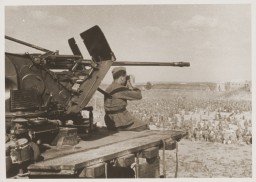
-
Display regarding the "Jewish Question"
PhotoA Hochheim parade float proceeds down the Kirchstrasse, passing by a display box for Der Stürmer, an antisemitic newspaper. The display box bears the slogan, "Without a solution to the Jewish question, there is no salvation for the German people." Hochheim am Main, Germany, circa 1934–1940.
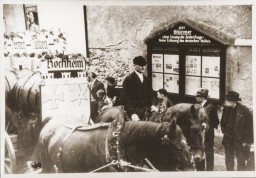
-
Spectators cheer as Hitler leaves for the Reichstag
PhotoCheering spectators greet Hitler upon his departure for the Reichstag session at which the Enabling Act was passed. The act allowed the government to issue laws without the consent of Germany’s parliament, laying the foundation for the complete Nazification of German society.

-
Prewar portrait of Dorrith Oppenheim
PhotoDorrith was born in Kassel, Germany, in December 1938. Her parents were Hans and Trudi Oppenheim. Following increased anti-Jewish measures, Dorrith was among the children sent on Kindertransports to find refuge in the United Kingdom. She left Germany on July 24, 1939. She never saw her parents again. They were deported to Auschwitz, where they perished in October 1944.
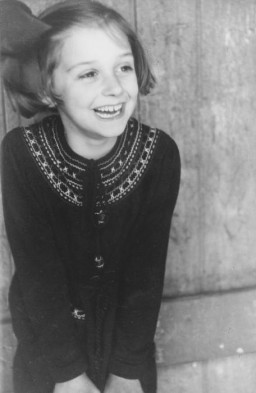
-
SS troops enter the Kroll Opera House
PhotoOn the day of the vote on the so-called Enabling Act, the Nazi leadership sent SS troops into the makeshift Reichstag building, formerly the Kroll Opera, to intimidate other political parties. Berlin, Germany, March 23, 1933. The Enabling Act allowed the Reich government to issue laws without the consent of Germany’s parliament, laying the foundation for the complete Nazification of German society. The full name of the law was the “Law to Remedy the Distress of the People and the Reich.”
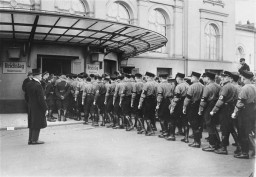
-
Personal Stories: Jewish Partisans
ProjectThe following list of Jewish partisans features personal stories from the Jewish Partisan Educ...
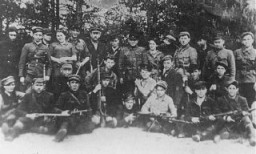
-
The Holocaust: A Learning Site for Students
ProjectLearning about the Holocaust is one way to honor those lost. Browse our learning site for students as a resource for Holocaust-education projects.
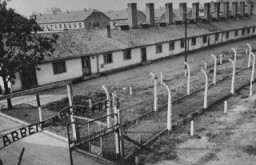
-
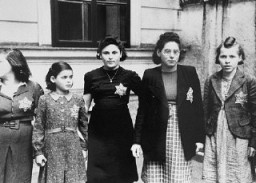
-
Diaries and Journals
ProjectDiaries reveal some of the most heart-wrenching accounts of the Holocaust. They record the feelings of loss, fear, and sometimes hope of those facing extraordinary peril.

-
The Holocaust and World War II in Ukraine
ProjectExplore the history of Jews in Ukraine before, during, and after the Holocaust through articles, personal stories, historical photographs, artifacts, maps, and more.
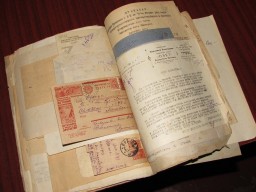
-
Nazi Propaganda
SeriesKey principles, strategies, and people in the history of Nazi propaganda during the Nazi rise to power, the Third Reich, "Final Solution," and World War II.
-
North Africa
SeriesLearn about North Africa's Jewish communities; WWII military campaigns in North Africa; Vichy's introduction of race laws; and networks of labor camps in North Africa.
-
Bergen-Belsen
SeriesSeries of articles about the establishment of the Bergen-Belsen camp and key dates in its existence as a concentration camp in the Nazi camp system

-
Adolf Hitler
SeriesRead a series of articles about Adolf Hitler's ideology and strategies. Under Hitler, the Nazi regime was responsible for the mass murder of 6 million Jews and millions of other victims
-
Theresienstadt
SeriesLearn about the Theresienstadt camp/ghetto, which served multiple purposes from 1941-45 and had an important propaganda function for the Germans.
-
Warsaw
SeriesBefore World War II, Warsaw was a major center of Jewish life and culture in Poland. Browse articles describing the German invasion, the Warsaw ghetto, deportations, and resistance.
